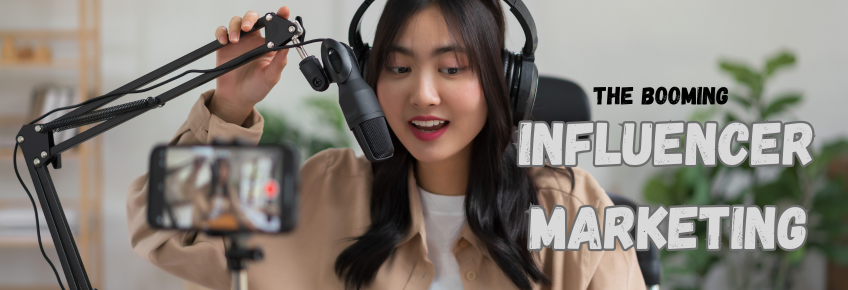In today’s digital age, it seems like everyone’s talking about Influencer Marketing. But what exactly is it? Influencer marketing is when companies collaborate with individuals who have a strong online presence to promote their products or services. These individuals, known as influencers, have built a loyal following on platforms like Instagram, YouTube, or TikTok, and their opinions and recommendations can impact the purchasing decisions of their audience. So, what’s the deal with influencer marketing in 2024? Let’s dive in and explore the trends and best practices.
Influencer Marketing in 2024: Trends and Best Practices

- by TheAce
1. Authenticity Is Key:
In 2024, authenticity remains at the leading position of influencer marketing. Audiences are becoming increasingly knowledgeable and can quickly spot insincere endorsements. That’s why it’s crucial for brands to partner with influencers who genuinely believe in their products or services. Authenticity builds trust between the influencer and their audience, resulting in more meaningful connections and higher engagement rates.
2. Video Content Dominates:
Video content continues to hold power in influencer marketing. Platforms like YouTube, TikTok, and Instagram Reels have transformed how brands connect with their target audience. In 2024, brands are increasingly collaborating with influencers to create engaging video content that entertains, educates, or inspires viewers. Whether it’s a product review, a tutorial, or a behind-the-scenes look, video content allows brands to showcase their offerings in a captivating way.
3. Data-Driven Strategies Deliver Results:
In 2024, data analytics play a crucial role in marketing campaigns. Brands are utilizing advanced analytics tools to track key performance metrics, such as reach, engagement, and conversion rates. By analyzing this data, brands can optimize their influencer partnerships for maximum impact. Data-driven strategies allow brands to identify which influencers are driving the best results and allocate their resources accordingly, ensuring a higher return on investment.
4. Micro-Influencers Are on the Rise:
While mega-influencers with millions of followers still manipulate, micro-influencers are gaining grip in 2024. These influencers have smaller but highly engaged followings within specific niches. Partnering with micro-influencers allows brands to reach targeted audiences more effectively and often at a lower cost. Plus, micro-influencers tend to have a more personal connection with their followers, making their recommendations even more impactful.
5. Transparency and Disclosure Are Non-Negotiable:
With increasing observation from consumers and regulatory bodies, transparency and disclosure are more important than ever. In 2024, brands are ensuring that influencers clearly disclose their partnerships and sponsored content to their audience. This transparency not only builds trust but also helps brands follow with advertising regulations. By being honest about sponsored content, influencers can maintain authencity with their followers and avoid any potential criticism.
6. Authenticity Beats Follower Count:
In 2024, brands are prioritizing authenticity over follower count when choosing influencers to collaborate with. While mega-influencers may have millions of followers, their engagement rates can vary widely. Brands are increasingly turning to influencers with limited followers but highly engaged followings, as they often deliver better results. Authenticity, relatability, and trustworthiness are valued more than unqualified numbers when it comes to influencer marketing success.
7. Measuring the Success of the Campaign:
Brands can measure the effectiveness of campaigns by tracking key metrics such as reach(how many people saw it), engagement(how many people interacted with it), conversion rates(how many actually buy something from it), and return on investment [ROI](how much money they made after investing in it). These metrics provide insights into the campaign’s performance which helps brands evaluate its impact on brand awareness, customer engagement, and ultimately, sales.
In conclusion, influencer marketing continues to evolve in 2024, with authenticity, remaining crucial. Brands are embracing micro-influencers, video content, long-term partnerships, diversity, data-driven strategies, transparency, and authenticity to drive success in their influencer marketing campaigns. By staying ahead of the trends and adopting best practices, brands can leverage the power of influencer marketing to effectively reach and engage their target audience in 2024 and beyond.
FAQs:
1. What exactly is influencer marketing?
Influencer marketing is when companies collaborate with individuals who have a strong online presence to promote their products or services.
2. What are micro-influencers?
Micro-influencers are individuals with smaller but highly engaged followings within specific niches.
3. Why are micro-influencers gaining popularity?
Micro-influencers are gaining popularity because they allow brands to reach targeted audiences more effectively and often at a lower cost.
4. What role does video content play in influencer marketing
Video content dominates as it allows brands to connect with their audience in a compelling and engaging way.
5. Why is transparency essential in influencer marketing?
Transparency is essential because it builds trust with the audience and helps brands comply with advertising regulations.
7. What are some best practices for collaborating with influencers?
The best practices are setting clear goals, talking about expectations early, and building long-lasting connections.
6. How can data-driven strategies improve marketing campaigns?
Data-driven strategies help optimize influencer partnerships for maximum impact by tracking key performance metrics and identifying which influencers drive the best results.
8. How can brands measure the success of campaigns?
Brands can measure success through metrics such as reach, engagement, conversion rates, and return on investment (ROI).
9. 9. What are some common mistakes to avoid in influencer marketing?
Common mistakes are not checking influencers carefully, not communicating clearly, and not being authentic.
10. What does the future hold for influencer marketing?
The future lies in continued innovation, deeper personalization, and adapting to evolving consumer behaviors and preferences.